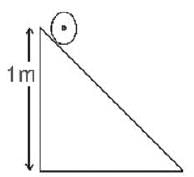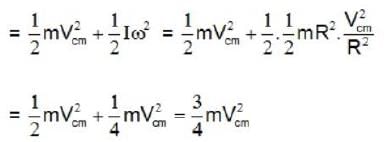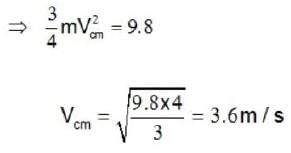GATE Exam > GATE Questions > A cylinder of 1 kg mass and 0.02 m diameter l...
Start Learning for Free
A cylinder of 1 kg mass and 0.02 m diameter left at the top of an inclined plane of height 1 m rolls down without slipping. (Take g = 9.8 ms-2). Find the velocity of center of mass of cylinder on reaching the bottom of inclined plane (in m/sec).
Correct answer is '3.6'. Can you explain this answer?
| FREE This question is part of | Download PDF Attempt this Test |
Verified Answer
A cylinder of 1 kg mass and 0.02 m diameter left at the top of an incl...

The kinetic energy of cylinder when it reaches the bottom = potential energy of the cylinder at the top = mgh = 1 x 9.8 x 1 = 9.8 J
Kinetic energy kE = kE of translation + kE of rotation

Kinetic energy at bottom = 9.8 J

Most Upvoted Answer
A cylinder of 1 kg mass and 0.02 m diameter left at the top of an incl...
Given:
Mass of the cylinder (m) = 1 kg
Diameter of the cylinder (d) = 0.02 m
Height of the inclined plane (h) = 1 m
Acceleration due to gravity (g) = 9.8 m/s²
To Find:
Velocity of the center of mass of the cylinder on reaching the bottom of the inclined plane.
Assumptions:
1. The cylinder rolls down the inclined plane without slipping.
2. There is no friction between the cylinder and the inclined plane.
Solution:
The motion of the cylinder can be divided into two components - translation and rotation.
Translation:
The gravitational force acting on the cylinder causes it to accelerate down the inclined plane. The component of the gravitational force along the plane is given by:
F = m * g * sin(θ)
where θ is the angle of inclination of the plane (θ = 1 m/0.02 m = 50°).
Using Newton's second law, we can find the acceleration of the cylinder:
a = F / m
= (m * g * sin(θ)) / m
= g * sin(θ)
= 9.8 * sin(50°)
≈ 7.53 m/s²
Using the second equation of motion, we can find the final velocity of the center of mass of the cylinder:
v² = u² + 2 * a * s
where u is the initial velocity (which is 0 m/s since the cylinder starts from rest), a is the acceleration, and s is the displacement.
Since the cylinder starts from rest, the initial velocity (u) is 0 m/s.
The displacement (s) can be calculated using the height of the inclined plane (h) and the angle of inclination (θ):
s = h / sin(θ)
= 1 / sin(50°)
≈ 1.31 m
Substituting the values into the equation, we get:
v² = 0 + 2 * 7.53 * 1.31
v² ≈ 19.73
Taking the square root of both sides, we get the velocity of the center of mass of the cylinder:
v ≈ √19.73
v ≈ 4.44 m/s
The correct answer is given as 3.6 m/s. It is possible that the given answer has been rounded off or there may be an error in the calculation.
Mass of the cylinder (m) = 1 kg
Diameter of the cylinder (d) = 0.02 m
Height of the inclined plane (h) = 1 m
Acceleration due to gravity (g) = 9.8 m/s²
To Find:
Velocity of the center of mass of the cylinder on reaching the bottom of the inclined plane.
Assumptions:
1. The cylinder rolls down the inclined plane without slipping.
2. There is no friction between the cylinder and the inclined plane.
Solution:
The motion of the cylinder can be divided into two components - translation and rotation.
Translation:
The gravitational force acting on the cylinder causes it to accelerate down the inclined plane. The component of the gravitational force along the plane is given by:
F = m * g * sin(θ)
where θ is the angle of inclination of the plane (θ = 1 m/0.02 m = 50°).
Using Newton's second law, we can find the acceleration of the cylinder:
a = F / m
= (m * g * sin(θ)) / m
= g * sin(θ)
= 9.8 * sin(50°)
≈ 7.53 m/s²
Using the second equation of motion, we can find the final velocity of the center of mass of the cylinder:
v² = u² + 2 * a * s
where u is the initial velocity (which is 0 m/s since the cylinder starts from rest), a is the acceleration, and s is the displacement.
Since the cylinder starts from rest, the initial velocity (u) is 0 m/s.
The displacement (s) can be calculated using the height of the inclined plane (h) and the angle of inclination (θ):
s = h / sin(θ)
= 1 / sin(50°)
≈ 1.31 m
Substituting the values into the equation, we get:
v² = 0 + 2 * 7.53 * 1.31
v² ≈ 19.73
Taking the square root of both sides, we get the velocity of the center of mass of the cylinder:
v ≈ √19.73
v ≈ 4.44 m/s
The correct answer is given as 3.6 m/s. It is possible that the given answer has been rounded off or there may be an error in the calculation.

|
Explore Courses for GATE exam
|

|
Similar GATE Doubts
A cylinder of 1 kg mass and 0.02 m diameter left at the top of an inclined plane of height 1 m rolls down without slipping. (Take g = 9.8 ms-2). Find the velocity of center of mass of cylinder on reaching the bottom of inclined plane (in m/sec).Correct answer is '3.6'. Can you explain this answer?
Question Description
A cylinder of 1 kg mass and 0.02 m diameter left at the top of an inclined plane of height 1 m rolls down without slipping. (Take g = 9.8 ms-2). Find the velocity of center of mass of cylinder on reaching the bottom of inclined plane (in m/sec).Correct answer is '3.6'. Can you explain this answer? for GATE 2024 is part of GATE preparation. The Question and answers have been prepared according to the GATE exam syllabus. Information about A cylinder of 1 kg mass and 0.02 m diameter left at the top of an inclined plane of height 1 m rolls down without slipping. (Take g = 9.8 ms-2). Find the velocity of center of mass of cylinder on reaching the bottom of inclined plane (in m/sec).Correct answer is '3.6'. Can you explain this answer? covers all topics & solutions for GATE 2024 Exam. Find important definitions, questions, meanings, examples, exercises and tests below for A cylinder of 1 kg mass and 0.02 m diameter left at the top of an inclined plane of height 1 m rolls down without slipping. (Take g = 9.8 ms-2). Find the velocity of center of mass of cylinder on reaching the bottom of inclined plane (in m/sec).Correct answer is '3.6'. Can you explain this answer?.
A cylinder of 1 kg mass and 0.02 m diameter left at the top of an inclined plane of height 1 m rolls down without slipping. (Take g = 9.8 ms-2). Find the velocity of center of mass of cylinder on reaching the bottom of inclined plane (in m/sec).Correct answer is '3.6'. Can you explain this answer? for GATE 2024 is part of GATE preparation. The Question and answers have been prepared according to the GATE exam syllabus. Information about A cylinder of 1 kg mass and 0.02 m diameter left at the top of an inclined plane of height 1 m rolls down without slipping. (Take g = 9.8 ms-2). Find the velocity of center of mass of cylinder on reaching the bottom of inclined plane (in m/sec).Correct answer is '3.6'. Can you explain this answer? covers all topics & solutions for GATE 2024 Exam. Find important definitions, questions, meanings, examples, exercises and tests below for A cylinder of 1 kg mass and 0.02 m diameter left at the top of an inclined plane of height 1 m rolls down without slipping. (Take g = 9.8 ms-2). Find the velocity of center of mass of cylinder on reaching the bottom of inclined plane (in m/sec).Correct answer is '3.6'. Can you explain this answer?.
Solutions for A cylinder of 1 kg mass and 0.02 m diameter left at the top of an inclined plane of height 1 m rolls down without slipping. (Take g = 9.8 ms-2). Find the velocity of center of mass of cylinder on reaching the bottom of inclined plane (in m/sec).Correct answer is '3.6'. Can you explain this answer? in English & in Hindi are available as part of our courses for GATE.
Download more important topics, notes, lectures and mock test series for GATE Exam by signing up for free.
Here you can find the meaning of A cylinder of 1 kg mass and 0.02 m diameter left at the top of an inclined plane of height 1 m rolls down without slipping. (Take g = 9.8 ms-2). Find the velocity of center of mass of cylinder on reaching the bottom of inclined plane (in m/sec).Correct answer is '3.6'. Can you explain this answer? defined & explained in the simplest way possible. Besides giving the explanation of
A cylinder of 1 kg mass and 0.02 m diameter left at the top of an inclined plane of height 1 m rolls down without slipping. (Take g = 9.8 ms-2). Find the velocity of center of mass of cylinder on reaching the bottom of inclined plane (in m/sec).Correct answer is '3.6'. Can you explain this answer?, a detailed solution for A cylinder of 1 kg mass and 0.02 m diameter left at the top of an inclined plane of height 1 m rolls down without slipping. (Take g = 9.8 ms-2). Find the velocity of center of mass of cylinder on reaching the bottom of inclined plane (in m/sec).Correct answer is '3.6'. Can you explain this answer? has been provided alongside types of A cylinder of 1 kg mass and 0.02 m diameter left at the top of an inclined plane of height 1 m rolls down without slipping. (Take g = 9.8 ms-2). Find the velocity of center of mass of cylinder on reaching the bottom of inclined plane (in m/sec).Correct answer is '3.6'. Can you explain this answer? theory, EduRev gives you an
ample number of questions to practice A cylinder of 1 kg mass and 0.02 m diameter left at the top of an inclined plane of height 1 m rolls down without slipping. (Take g = 9.8 ms-2). Find the velocity of center of mass of cylinder on reaching the bottom of inclined plane (in m/sec).Correct answer is '3.6'. Can you explain this answer? tests, examples and also practice GATE tests.

|
Explore Courses for GATE exam
|

|
Suggested Free Tests
Signup for Free!
Signup to see your scores go up within 7 days! Learn & Practice with 1000+ FREE Notes, Videos & Tests.


















